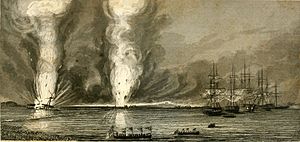Battle of First Bar
| Battle of First Bar | |||||||
|---|---|---|---|---|---|---|---|
| Part of the First Opium War | |||||||
 Attack on the First Bar battery (published 1843) |
|||||||
|
|||||||
| Belligerents | |||||||
|
|
|||||||
| Commanders and leaders | |||||||
|
James Bremer Thomas Herbert |
Hsiang-fu (KIA) Yung-fu |
||||||
| Strength | |||||||
| 7 ships | 2,000+ troops 40+ junks |
||||||
| Casualties and losses | |||||||
| 1 died of accident 8 wounded |
~300 killed or wounded 98 guns captured |
||||||
The Battle of First Bar was fought between British and Chinese forces at First Bar Island and its surrounding area in the Pearl River, Guangdong province, China, on 27 February 1841 during the First Opium War.
On 21 February 1841, former Imperial Commissioner Lin Zexu wrote that 1,000 regular troops from Hunan and the same number from Yunnan arrived in batches at Canton (Guangzhou). Lin met General Hsiang-fu of the Hunan troops in the afternoon and then General Yung-fu the next day. On 24 February, Lin, Imperial Commissioner Qishan, and other officials inspected the defences of the Pearl River, and spent the night at Lieh-te, 7 miles (11 km) east of Canton. The inspection continued the next day and ended early on 26 February at Ta-huang-chiao, 8 miles (13 km) south of Canton.
On the morning of 27 February, Calliope, Herald, Alligator, Sulphur, Modeste, and the steamers Madagascar and Nemesis sailed past the Bocca Tigris along the Pearl River. Lieutenant John Elliot Bingham of the Modeste wrote, "As these ships sped along, the shore was lined with thousands of the inhabitants gazing on the bold barbarians, many of them, no doubt, secretly wishing them success." Commodore James Bremer, commander-in-chief of British forces, placed Captain Thomas Herbert of Calliope in command of the fleet. After sailing past Tiger Island and Second Bar, they reached near First Bar Island by noon. There, the British spotted Cambridge, a former East Indiaman, hoisting the red flag of a Chinese admiral. The long Chinese field fortifications facing the river mounted 47 guns, and rows of white tents in the neighbouring paddy fields indicated a large number of Tartar troops. Over 40 war junks were further up the river.
...
Wikipedia
